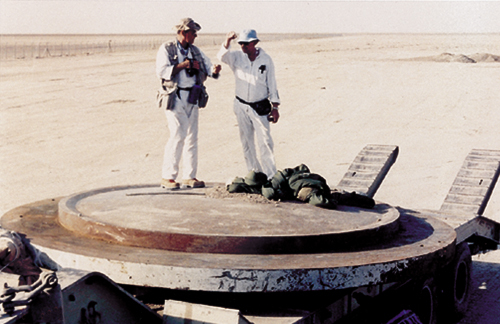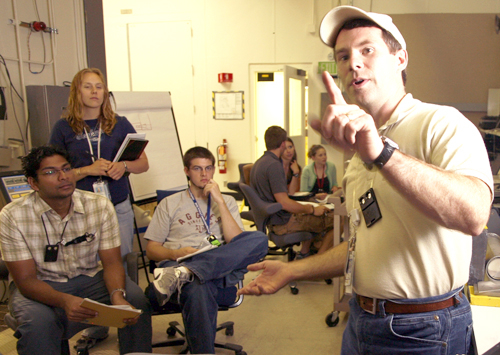Lab plays global role in nuclear safeguards
We all recall the dramatic photos of the United Nations Special Commission (UNSCOM)/International Atomic Energy Agency (IAEA) inspectors standing on the giant calutron magnets partially buried in the desert as the extent of Saddam Hussein’s nuclear weapons program came to light following the first Gulf War (1990). While Iraq was successfully prevented from "going nuclear," the IAEA’s verification activities typically operate far from the spotlight.
The IAEA was set up by the United Nations in 1957 to help nations develop nuclear energy for peaceful purposes. It also was charged with verifying that peaceful nuclear facilities and materials are not diverted for military purposes. To that end, the agency carries out regular inspections of nearly 900 nuclear facilities and several hundred other locations in 57 non-nuclear weapon countries.
Just as audits build confidence in proper financial conduct and prevent embezzlement, safeguards help detect and deter nuclear proliferation. IAEA inspectors verify the accuracy of country-supplied documentation by checking nuclear material inventories and conducting sampling and analysis of materials to provide assurance that the nuclear materials and facilities are being used exclusively for peaceful purposes.
In addition, technical measures such as surveillance cameras and other instrumentation, are installed at the facilities to provide continuous monitoring and detect unreported movement or tampering with nuclear materials. To the extent feasible, IAEA inspectors also look for and investigate indications of clandestine nuclear activities that should have been declared but were not.
The United States is the largest contributor of safeguards technology and personnel to the IAEA, and the Laboratory is a contributor to the U.S. safeguards effort.
"The safeguards system is under a lot of strain," said Mona Dreicer, program leader for Nonproliferation and International Security within the Global Security Principal Directorate. She began her career assessing the heath and environmental risks of radiation in the environment at other U.S. national laboratories and the IAEA, and became involved in nonproliferation and arms control about 14 years ago at the U.S. Arms Control and Disarmament Agency and the U.S. State Department.
Over the past 25 years, the number of safeguarded facilities has more than tripled and the amount of nuclear material under safeguards has increased sixfold. Compounding the challenge is the fact that large numbers of safeguards professionals, both in the United States and at the IAEA, are nearing retirement age.
"The IAEA is stretched to the extreme, what with Iran, North Korea and Syria as well as the emergence of black market nuclear proliferation networks and the growth of nuclear power around the world," Dreicer said.
To help the IAEA meet these critical challenges, the Department of Energy and the National Nuclear Security Administration (NNSA) have launched the Next Generation Safeguards Initiative (NGSI). As announced on Sept. 17, 2007, by then-Secretary of Energy Samuel Bodman at the IAEA General Conference, the goal of the initiative is to "ensure that modern technology, the best scientific expertise and adequate resources are available to keep pace with expanding IAEA responsibilities."
During the last year, Dreicer spent roughly half of her time in Washington D.C., helping NNSA’s Office of Nonproliferation and International Security (NA-24) write the program plan for implementing NGSI. The initiative consists of five program elements — policy development and outreach, safeguards concepts and approaches, technology and analytical methodologies, human resources development and infrastructure development.
Arden Dougan and Keith Bradley, both of Global Security, are spearheading LLNL’s effort to develop evolutionary and revolutionary improvements to safeguards technology. Examples of current projects include the Ultraspec microcalorimeter; the spent fuel pin diversion detector; the antineutrino-detector reactor monitor, developed with funding from NNSA’s Office of Nonproliferation Research and Development (NA-22); and the GeMini handheld high-resolution gamma spectrometer, developed with support from NA-24.
LLNL also is a key contributor to another main NGSI thrust, which aims to train the next generation of safeguards professionals. Dreicer oversaw two pilot internship programs during the summer of 2008. These graduate-level university-laboratory collaborations focused on safeguards technology, in collaboration with Texas A&M University and Los Alamos National Laboratory; and on safeguards policy and information assessment, in collaboration with the Monterey Institute of International Studies.
"Forty-four students participated in these internship programs," Dreicer explained. "In addition to several weeks of intensive course work, the students worked on specific safeguards-related projects under the guidance of laboratory mentors."
The programs concluded with a symposium at Livermore, where the participants presented their projects in a poster session and toured the Laboratory. "This symposium brought the two pilot programs together to facilitate cross-communication between the policy and technology tracks and gave the students experience in publicly presenting their work," Dreicer said.
Dougan, Jonathan Essner and other Global Security colleagues were actively involved in bringing these pilot courses to fruition by providing lectures and mentoring summer interns, and they are deep into the preparations for the 2009 summer programs.
"Based on feedback from last year’s students, we’re refining the two programs for this summer," Dreicer said. "We hope that having been introduced to the real world of safeguards, the students participating in these programs will be motivated to pursue safeguards-related careers in government, industry or the IAEA.
"International safeguards are vitally important for nonproliferation and global security," Dreicer noted, "and success depends on achieving an essential blend of U.S. and international policy with technological solutions.
"I’m hoping that through these internship programs, and the Next Generation Safeguards Initiative as a whole, we can attract new talent to the field and develop new ideas and technologies to help the United States and IAEA accomplish their safeguards missions."






